Policing During a Pandemic: The Mayor Must Alter City's Approach
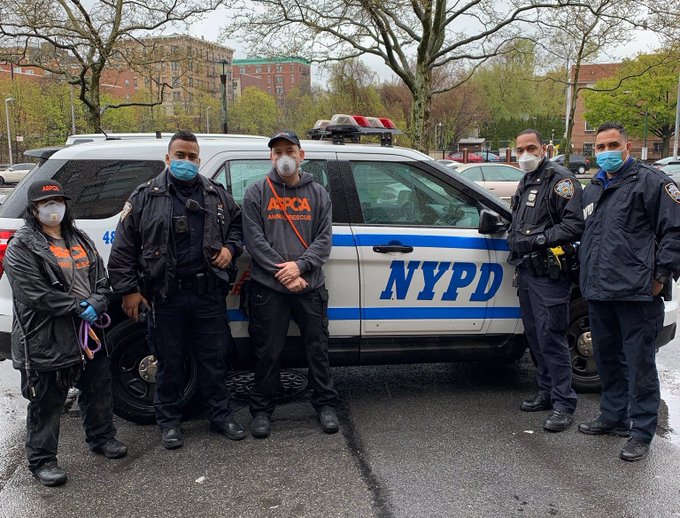
Policing during a pandemic (photo: @NYPDnews)
As we face one of the most pressing global health crises in over a century, New York City continues to use ineffective and, at times, discriminatory policing practices. For evidence that they aren’t working, one need look no further than the controversy regarding the de Blasio administration’s clumsy attempt to manage the crowd attending the funeral of Rabbi Chaim Mertz, a revered leader of Williamsburg’s Orthodox Jewish community. For even more recent proof, there's the disturbing video of an incident in lower Manhattan that started with officers policing social distancing and ended with a violent, seemingly unprovoked assault on, and arrest of, an innocent bystander.
The city maintains it is following the recommendations in the Centers for Disease Control and Prevention’s Guidelines for Coronavirus Prevention, the first of which is to follow “tips for social distancing from authorities.” However, giving the responsibility to NYPD officers and expecting that they will safely and effectively administer these new guidelines is not an effective solution. Here are some of the specific problems with this approach:
NYPD officers still resort to tactics that their training and own inclinations lead them to; they use force and intimidation to resolve problems at hand—a “might makes right” approach that is exactly the wrong way to achieve the community’s compliance with social distancing requirements.
Officers must break social distancing rules to issue a summons or make an arrest. This activity puts both officers and members of the public at risk.
Over 7,000 of the 36,000-member police force have called in sick since the pandemic began affecting New York, and more than 2,000 police officers have returned to work after “recovering from the virus.” As we learn more about how the coronavirus spreads and how symptoms do not show up for several days if at all in some people who carry the virus, we cannot be sure that more NYPD officers aren't sick than what has been reported.
NYPD arrest and ticketing practices disproportionately target low-income black and Hispanic communities. These practices create a greater risk for vulnerable communities during the pandemic.
The fines officers issue for social distancing violations range from $500-$1,000, an unreasonable burden, especially for the poor New Yorkers of color who are and will be experiencing the brunt of police actions.
On the other hand, we offer suggested practices that will make compliance with social distancing a safer and fairer process for all our communities:
End the use of the NYPD (and other police forces) as the enforcers of state and city social distancing orders.
Enlist community leaders and local clergy with the responsibility to achieve compliance with social distancing and other relevant rules and to work with their communities on a collaborative basis to ensure safety without involving punitive law enforcement practices.
As examples of the kind of community leaders who can perform social policing effectively, the city should look to the credible messengers who carry out the central work of the Cure Violence programs that are located in neighborhoods throughout the city and that have proven successful in working with young gang members to significantly reduce local conflicts.
Furlough some NYPD officers to reduce the number of cops on the street and to curtail the spread of the virus.
More effective and benign, these measures will help achieve the desired goal: a safe, just, and healthy city for all New Yorkers. Now more than ever, it is imperative that we rely on our communities to protect and care for their neighbors. We are the ones who keep us safe. It is people, not police, who will achieve that critically important goal.
***
Bob Gangi is the executive director of PROP, the Police Reform Organizing Project, where Luke Messina is associate director; Marzian Alam is policy analyst; and Mikaela Berry is communications coordinator. On Twitter @PROPNYC.
***
Have an op-ed idea or submission for Gotham Gazette? Email This email address is being protected from spambots. You need JavaScript enabled to view it.
Not a Novel Crisis at CUNY
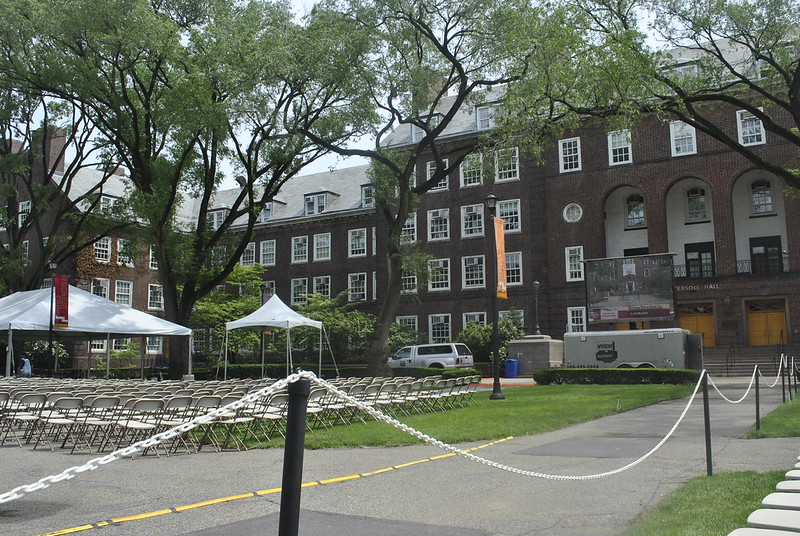
CUNY is closed (photo: Brooklyn College)
What does an educational crisis look like in a plague year? How can I convey, from inside a health emergency, that the City University of New York has been in a slow-burn, decades-long state of crisis? COVID-19 is a matter of life and death, while higher education is not. Yet the COVID-19 pandemic reveals with new urgency, rather than diminishes by comparison, CUNY’s longstanding, systemic failures.
We need to grasp the relationship between this novel coronavirus and CUNY if we want to make a better future for New Yorkers and their city. New York City’s public higher education system and the public health system are connected, each overwhelmed, under-resourced, and fighting for the same tax dollars. They are mirrors of each other, two reflections of a government reneging on its responsibility to the public good, even in the strongest economic times. In the mirror of the virus, which has preyed upon long-standing disparities in our society, we see…
…the State rushing to buy poor CUNY students the technology they need for distance learning now that professors and students cannot meet in person for fear of contagion. But our students needed that technology before COVID-19, and where was the State of New York?
Take a pre-COVID look at CUNY’s campuses and you’ll see that we don’t have printer paper, that our college libraries can’t buy books, and that tenure track faculty can be found in less than half of our classrooms.
We see the unprepared State urgently seeking personal protective equipment and ventilators. At the same time, my college has not had hot water in its restrooms for years, nor decent and affordable food on campus. Black mold, open elevator shafts, and vermin in the halls of CUNY are well documented on social media (see #brokelyncollege, for instance). Just as New York needs short-term healthcare heroics to fight the virus, we need long-term healthcare heroics to make our educational environments safe.
We see with fresh eyes that the State has for decades refused to fund the MTA, the primary source of transit for CUNY’s city-wide commuters. As COVID-19 now makes a ghost ship of the MTA in more affluent neighborhoods and a human petri dish in poorer neighborhoods, are we to forget that for years the State’s slow, dilapidated trains and buses have translated directly into late students, missed classes, lower grades, and unconscionably high dropout rates at CUNY?
In an echo of New York City’s most deadly modern plague, AIDS, COVID-19 is again punishing our most despised, our poorest, most harshly. These are our low-income CUNY students, our precarious Dreamers, our full-time working students with no margin for educational error. Whatever COVID-19 costs, the underclass, black, brown, and ethnic white CUNY community is sure to pay in a special way. We know this from long years of experience.
What the coronavirus brings into startling clarity is that we need to stop using the same threadbare language we’ve long used, perversely, to cast CUNY’s failures as its strengths: “aspiration” (in the face of massive defunding and managed inequity), “social mobility” (for the minority of students who graduate), and our “democratizing mission” (despite constant tuition increases and the ever-widening material disparities between CUNY and rich schools). Metaphors, whether of crisis or hope, will not help us now.
What will happen to CUNY after COVID-19? Beyond dire prediction and revolutionary hope lies a confrontation with the mundane, deeply structural crisis that defines CUNY and public education. The very least we can do is admit that in the years of shortsighted austerity budgeting since the 2008 recession CUNY has managed to become—has been managed to become—less rather than more prepared to meet the current moment.
Governor Cuomo must use the timing of COVID-19 to set a new timeline for CUNY. Before the urgency of the health crisis ends, let tuition at CUNY end. Before COVID-19 kills more of our faculty, let CUNY commit to doubling its full-time, tenure-track faculty and to providing our well-qualified adjuncts clear routes to those new jobs. Before COVID-19 becomes a normalized health disaster, let us disrupt New York’s educational disaster by calling it by that very name. For as CUNY’s 275,000 students and 45,000 instructional faculty and staff know, our crisis is anything but novel.
***
Matt Brim is an associate professor of queer studies at the College of Staten Island, CUNY, and part of the Women's and Gender Studies Faculty, CUNY Graduate Center. His most recent book, Poor Queer Studies: Confronting Elitism in the University, was published in March 2020 by Duke University Press. On Twitter @mattbrimnyc.
***
Have an op-ed idea or submission for Gotham Gazette? Email This email address is being protected from spambots. You need JavaScript enabled to view it.
Expand ‘Right to Counsel’ to Protect Our Families and Small Businesses from Homelessness and Financial Ruin
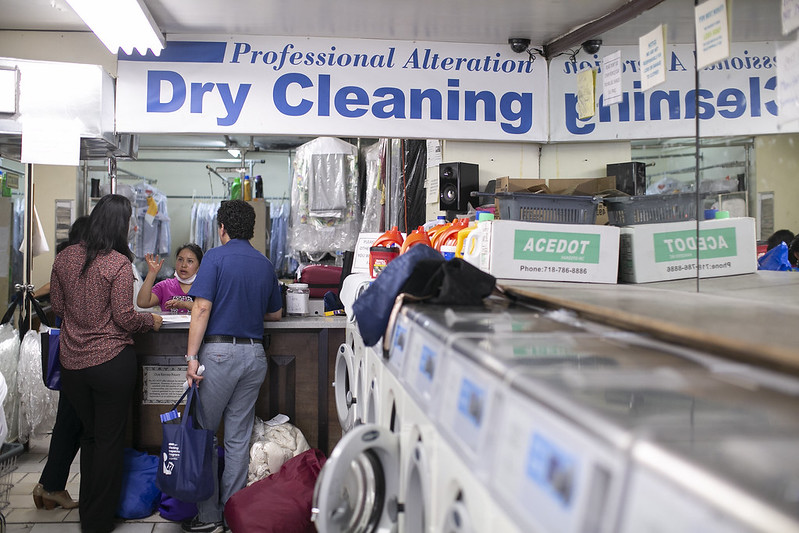
Small businesses are closed or on the brink across the city (photo: William Alatriste/City Council)
The day after the 90-day moratorium on eviction ends, residential and commercial eviction proceedings will potentially flood our courts, leaving families and small businesses gasping for air.
Amid this pandemic, it is imperative that New York City expands the Right to Counsel law by increasing legal capacity to meet the inevitable COVID-19 eviction demand, and, building on this model, establish a new initiative to provide free legal representation to vulnerable small businesses.
The Right to Counsel law, sponsored in 2017 by City Council Members Mark Levine and Vanessa Gibson, guarantees that low-income families falling below 200% of the federal poverty line have access to free attorneys in housing court. In a show of remarkable success, this law allowed 84 percent of families facing eviction to stay in their homes.
Now more than ever, these protections are critical to preventing homelessness and financial ruin for our residents. Council Members Levine and Gibson are now championing Right to Counsel 2.0, which would increase the income eligibility guidelines to 400% above the federal poverty line, delivering a huge win for tenants.
Adding to these efforts, we need federal and state support for rent relief, and the City Council should increase attorney staffing capacity in each zip code that is currently covered by the law to meet the heightened eviction demand that will follow after the eviction moratorium is lifted. The Council should also expedite the application of the current Right to Counsel law to zip codes where the law is currently not in effect (but slated to be implemented by 2022) to help those families that have had to bear the brunt of the coronavirus.
For instance, zip codes like 10032 and 10040 in Washington Heights, which are not currently receiving representation under the law, have reported high incidences of COVID-19 cases as compared to other neighborhoods of New York City.
Building on the Right to Counsel model, the City Council should employ its budgetary discretion to establish a similar initiative for small business owners. This initiative would fund nonprofit providers to offer comprehensive legal support for qualifying small businesses, particularly in neighborhoods like Washington Heights, Harlem, Elmhurst, Mott Haven, and Kingsbridge.
Nonprofits should be provided funding to assist vulnerable small businesses with free attorneys to negotiate, among other things, new language to their original commercial leases, giving them the greatest protection possible. Here, an attorney’s lease interpretation skills could result in positive outcomes for commercial tenants, such as a rent arrears repayment plan or a shortened contractual obligation period for which they have to pay rent. And if negotiations fail, this initiative would also provide free legal representation for qualifying small businesses in commercial eviction proceedings in court.
Indeed, these proposals have costs — but this is a perfect time for New York City to prioritize long-standing needs of our hard-working families. New Yorkers are counting on policy-makers to be courageous and make bold decisions to steer us in the right direction. We need to get it done.
***
Shaun Abreu is a tenants’ rights attorney and represents low-income tenants covered under the Right to Counsel law in Housing Court. He is a candidate for City Council in Manhattan’s District 7. On Twitter @ShaunAbreu.
***
Have an op-ed idea or submission for Gotham Gazette? Email This email address is being protected from spambots. You need JavaScript enabled to view it.
Mayor De Blasio: Restore Funding to Summer Youth Employment for Teens Who Need It, Like Me
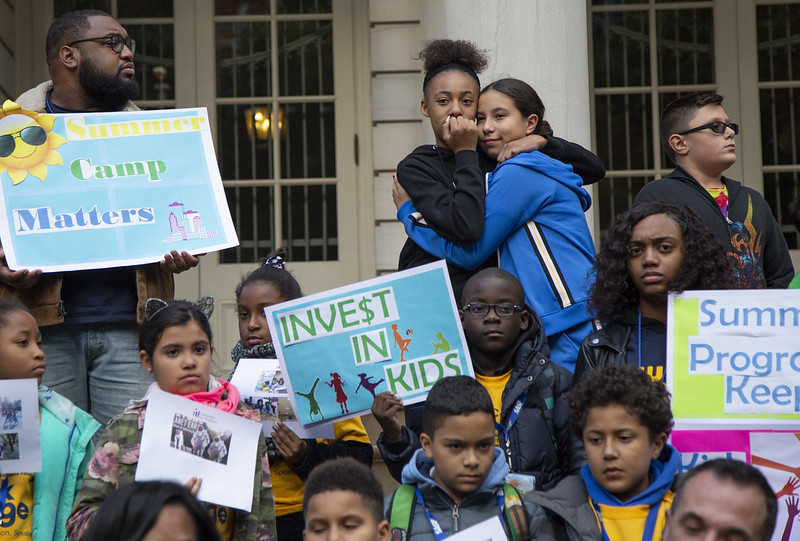
Tens of thousands of young New Yorkers rely on SYEP (photo: John McCarten/City Council)
When I first heard of the New York City Summer Youth Employment Program (SYEP) two years ago, I had just turned 14. I was so excited because that Fall I would enter high school and my family needed money to help pay for my uniform, school supplies, and books. Like a lot of New York families, money was already tight, so the prospect of getting a job where I could help my parents even just a little was an incredible opportunity.
Over the last two summers, SYEP has been a great experience that not only helped me make some money, but also helped prepare me for a better future. Before Mayor de Blasio announced he would be cutting SYEP funding this year as a result of coronavirus, I was already accepted for the summer of 2020, an opportunity I no longer have unless the city undoes that budget cut.
Before SYEP, I wasn’t sure what I wanted to pursue in college and possibly beyond. Then, last summer, I worked at State Farm, which helped me realize how much passion I had for business, finally giving me an idea of what I wanted to study. Through SYEP, I also entered the Work Learn Grow program, which gave me my start working in a social work environment -- a shelter, which completely changed my perspective on life, work, and society.
Through Work Learn Grow, I started working at Praxis Enterprise. Having small parties and celebrations for families living in the shelter brought me joy. Coming into work every day and hearing “Hi Leny! I missed you! Is there after school today?” made me happy. I could have had a bad day but knowing how much I can brighten someone's day - -even through their hardships -- was motivating in a whole new way.
It’s no secret that life for us all under quarantine has been difficult. Not being able to go outside, see my friends, or even go to school has taken a toll on me. I feel for those who have depression like me. I feel for those who are struggling to make ends meet. Sadly, I know I’m not alone. All of which is why I can’t help but think of the tens of thousands of teens just like me who would benefit from having the SYEP now more than ever, especially those whose family members have lost work because of the virus.
For the thousands of parents who don’t have a job, their children could help to fill the void of onerous expenses. Countless families could be saved using SYEP as a way to bring food to the table, transportation money, and to contribute to rent or other household needs.
But SYEP is about so much more than just a summer paycheck. It’s about getting the opportunity for real-world work experience so many thousands of us teens wouldn’t otherwise get. Being in SYEP helped me build my resume, which will help me for years to come as I apply to college and pursue other opportunities. SYEP, even if conducted remotely, still has the enormous potential to help teens like me far into our futures, beyond this summer. Without it, we risk falling much further behind our peers throughout the city.
If our school system of more than 1 million students could convert to remote learning in just a week, then surely there is a way to convert SYEP to provide remote jobs as well. Most students in New York City have electronic devices they can work on, many more so now that the city has been distributing devices for school purposes. This opportunity would be a huge help to the families who lost their main sources of income because of this pandemic.
I hope the mayor and City Council reverse course to help the youth of this city who were counting on summer employment opportunities even before this hard time set in, and need SYEP even more now. We depend on these jobs not just for this summer, but for our futures. Now is not the time to cut SYEP, now is when we need it most.
***
Karleny Ramos is a junior at the High School for Teaching and Professions in the Bronx and a member of Teens Take Charge. On Twitter @TeensTakeCharge.
***
Have an op-ed idea or submission for Gotham Gazette? Email This email address is being protected from spambots. You need JavaScript enabled to view it.
Healing the New York Region with Coordinated Planning
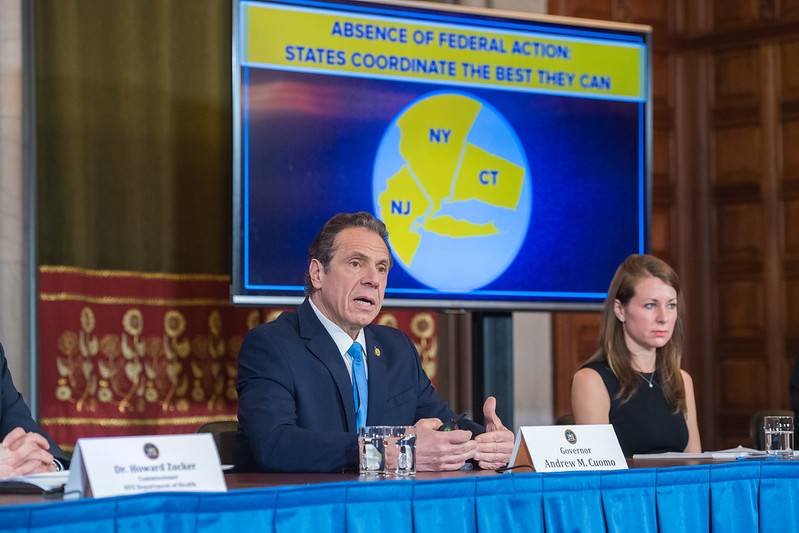
An argument for a regional approach to recovery (photo: Darren McGee/Governor's Office)
Even for a metropolitan area that experienced the trauma of September 11, 2001 and the devastation of Superstorm Sandy, nothing could prepare residents of New York and their neighbors in New Jersey and Connecticut for the COVID-19 crisis. The death toll has already far surpassed that of the World Trade Center attack and will continue to climb. The economic damage is certain to exceed the job and income losses of those events and the 2008 financial crisis combined. The impacts on our collective psyche won’t be fully known until well after the pandemic has passed.
More than even in those earlier disasters, the response to this crisis requires a coordinated effort from the states and communities that are intricately tied together in family, social, and business networks that use the same roads, trains, stores, offices, schools, parks, and public spaces, drink the same water, and breathe the same air.
The decision by Governors Cuomo, Murphy, and Lamont, and their fellow governors in four other northeastern states, to form a Regional Coronavirus Reopening Council is an unprecedented collaboration that is crucial to reopening their interdependent economies. The council can have an even greater impact if it lays the foundation of a coordinated, long-term strategy to build a region that is healthier, fairer, and more resilient.
Planning for the recovery needs to start with the realization that the region is very sick and still in intensive care. Easing stay-at-home orders and other restrictions too soon will result in more deaths, a likely return to lockdowns and a longer recovery.
Returning to full physical and economic health will also require treating the underlying conditions that made us so susceptible to this disease.
The vastly disproportionate impact that this has had on black, Latino, and Native American populations, and the racial profiling the has been targeting the Asian community, is rooted in our history of racism and segregation. The sharp divides between the affluent, the middle-class, and low-wage workers without benefits or savings is a glaring outcome of decades of growing economic inequality. High levels of air pollution and other environmental hazards have always been a health risk, and appear to make us particularly susceptible to serious coronavirus effects. The fragility of vital systems like the transit network and unemployment insurance is the result of decades of underfunding and a failure to modernize. Slow adaptation to climate change will lead to even greater vulnerability and inequity. Even immediate measures to restart the economy need to address these fundamental flaws.
All of these conditions are national in scope and call for a concerted national response. But both the unique character of the region and the scale of the epidemic here require a vision and plan for the tri-state metropolitan area at least, if not the entire Northeast. The governors, through the regional council, can set a course that both speeds recovery and begins fixing structural problems.
A starting point for the long view can be Regional Plan Association’s 2017 Fourth Regional Plan, a once-in-a-generation vision for the tri-state metropolitan area. Many of its recommendations will need to be reassessed in a post-COVID-19 world, but the long-term challenges addressed in the plan are, if anything, now more important to overcome. The values of health, equity, prosperity, and sustainability that shaped the plan can guide the actions we take at each stage of recovery and renewal.
As we transition to recovery, the immediate focus on coordinating guidelines for reopening and physical distancing can shift to incorporating health goals and metrics in all regional and state agencies. New York State’s health-in-all-policies guidelines are a good place to start. These will be particularly important in reducing the vast disparities in health outcomes by race and income.
A united effort to secure the region’s fair share of federal transit assistance is the first order of business to keep the region’s circulatory system from spiraling into decline, but why stop there? With support from the governors, the region’s transportation agencies could join in creating a universal fare-payment mechanism and start to integrate rail services to allow more direct, one-seat rides to different parts of the region.
The council could spearhead an effort to give affordable, reliable Internet service to every household in the region, eliminating a leading source of both urban and rural inequality while reducing the region’s vulnerability in future disasters. This could set the stage for more difficult but essential conversations on how to expand affordable housing and reduce segregation throughout the metropolitan area.
An economic restart may be our best opportunity to rebuild in a way that supports a healthier environment and greater resilience to both future pandemics and climate change. Interstate cooperation to reopen the economy can be a foundation for large-scale climate initiatives, such as expanding regional greenhouse gas reduction programs, scaling up renewable energy, and capitalizing adaptation trust funds.
Recovering from the coronavirus pandemic will require a mobilization of the region’s talents, resources, and political will to a degree not seen since at least the deep fiscal crisis of the 1970s. We have a chance to not only recover much of what we lost, but to heal the wounds and divisions that new calamities would otherwise exploit.
***
Chris Jones is Senior Vice President and Chief Planner at Regional Plan Association. On Twitter @RegionalPlan.
***
Have an op-ed idea or submission for Gotham Gazette? Email This email address is being protected from spambots. You need JavaScript enabled to view it.
Protect Democracy with Vote-by-Mail and Online Registration
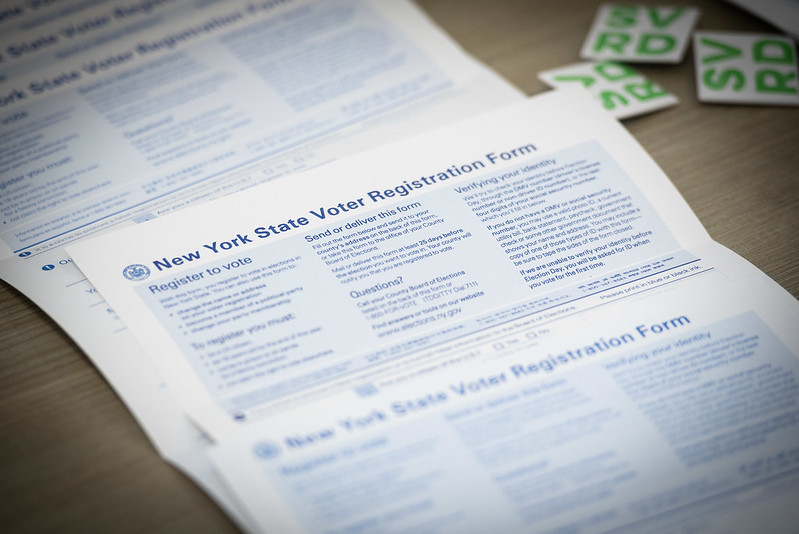
Next potential steps for voting in New York (photo: Michael Appleton/Mayor's Office)
The following is an excerpt from the 2019-20 NYC Votes Voter Analysis Report
Novel and frightening barriers to voting have the potential to upend the entire crucial 2020 election year in every state. The challenges of in-person voting during a pandemic are clear and significant. Elections traditionally provide a time for citizens to gather together in large numbers to engage in the practice of democracy. But restrictions on public gatherings recommended by public health authorities in response to the spread of COVID-19 cast regular poll site operations in a new light.
In jurisdictions around the country, many voters wait packed together in long lines to make their voices heard. Institutions that regularly serve as poll sites may be justifiably concerned about allowing potential carriers to pass through their doors—especially senior centers or schools. While early voting opportunities can provide space for voters to follow physical distancing guidelines, they offer no such protection to the dedicated poll workers who interact with each voter requesting a ballot.
In response, many election experts and advocates have advocated for prompt and widespread adoption of vote by mail.
Washington State, for instance, mails ballots to every registered voter 18 days before each election. Voters can mail their ballots back or return them to designated ballot drop boxes by the end of Election Day. Four other states—Colorado, Hawaii, Oregon, and Utah—conduct all-mail elections.
In New York State, mail-in or absentee voting is available only to voters who can attest to a specific reason they will be unable to appear at the polls, either for absence or illness. By executive order, Governor Cuomo expanded the meaning of “temporary illness” to cover those seeking to stem the spread of COVID-19, and mandated that every voter should receive an absentee ballot application in the mail. However, its effects are temporary. As issued, it applies only to elections through June 23. By whatever means are available, expanded access to vote by mail should be offered to New Yorkers on a permanent basis.
What we’ve learned in this moment is that universally-accessible vote by mail is not merely a turnout-boosting convenience. It can provide necessary resilience for our democratic system when the logistics of in-person balloting become impossible or impractical to maintain. It is one of a series of critical measures that should be available to administrators to ensure the continuity of our elections. New York should act promptly and decisively to implement it here.
The COVID-19 response effort is also shifting the way that organizers and campaigners approach the work of engaging voters. Traditional methods of registering voters will need to be rethought and campaign plans will need to be redesigned to adapt to the reality of an election year conducted during a pandemic. At minimum, a response that preserves New Yorkers’ access to elections through crises will require New York to finally end its reliance on a paper-based voter registration system that depends heavily on face-to-face interaction to bring new voters into the democratic process.
Times of crisis can force hard choices upon us; they demand we articulate our values and protect the things we value most. Elections are essential, particularly and especially in these difficult moments. In just the last twenty years, New Yorkers have come together to vote in the wake of a terrorist attack and in the aftermath of a destructive storm. Each instance demonstrates anew that our election laws and systems badly need flexibility to ensure elections can adapt effectively to public challenges like this one.
Democracy will persist — if we choose it.
***
Amy Loprest is the Executive Director of the NYC Campaign Finance Board, which runs the nonpartisan voter engagement initiative NYC Votes. Read the full 2019-20 NYC Votes Voter Analysis Report. On Twitter @NYCCFB & @NYCVotes.
***
Have an op-ed idea or submission for Gotham Gazette? Email This email address is being protected from spambots. You need JavaScript enabled to view it.
Aid to States is Important, But Next Federal Stimulus Must Truly Spark a People’s Recovery
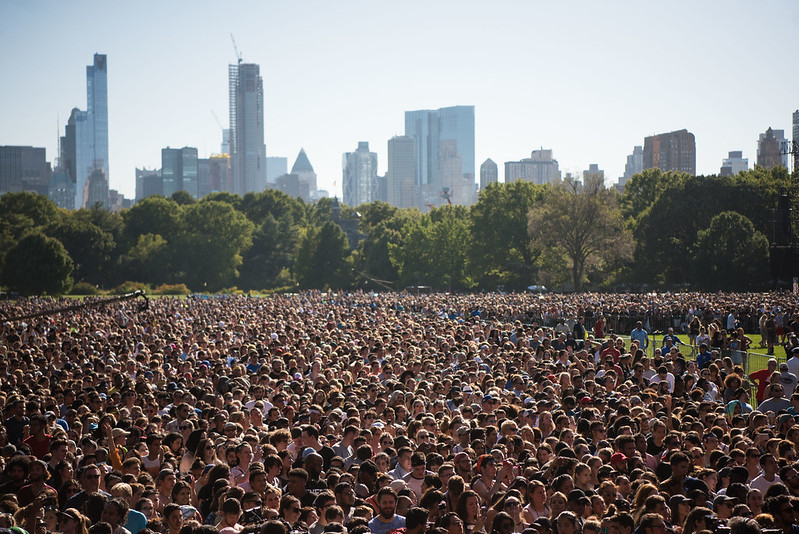
The people must be prioritized, the authors write (photo: Michael Appleton/Mayor's Office)
New York remains the epicenter of the fight against the COVID-19 pandemic. And we remain short of resources to tamp down transmission of the virus and to provide the critical economic relief to working families and the most vulnerable New Yorkers.
Our representatives in Congress need to make sure we get those resources in the next stimulus bill. And starting this week, we’ve been gathering New Yorkers from all across the state to join in the fight for a People’s Recovery that will benefit all of us.
It’s not just “PPE” -- personal protective equipment -- but also workplace protections, cash assistance, healthcare, housing aid, and safe housing for those of us who are homeless or incarcerated that are now essential to caring for our people and preventing more community transmission of the virus.
This crisis has laid bare the devastating inequality in our state and the failures of austerity policies that have left most of our communities woefully unprepared, while the wealthy and well-connected escape to well-stocked hideaways, where many of them profiteer on the pandemic.
The devastation has been hardest on communities of color, consistent with the systemic inequities in our education, healthcare, and economic systems.
Frontline workers -- many of whom are immigrants and all of whom don’t have the privilege to stay at home -- are putting their lives on the line to save our lives, deliver essentials, and keep food on all of our tables. Meanwhile, immigrant, homeless, and incarcerated communities have been largely left out of pandemic policies and planning.
The first three federal stimulus packages along with the latest supplementary package failed to deliver relief to those who need it the most. And our new state budget failed to reverse a decade of austerity, instead choosing cuts to critical pandemic response services over asking the wealthiest New Yorkers to chip in more.
Yes, we do need more unrestricted federal resources for state and local governments. But we also need more for regular New Yorkers struggling with the twin healthcare and economic impacts of the pandemic.
Senate Minority Leader Chuck Schumer and our congressional delegation must do better for New York.
We cannot accept another corporate-first stimulus package. We need a People’s Recovery that will regenerate society and tackle institutional inequality head-on. The next stimulus must:
Repair dangerous gaps in worker protections and address dangerous exclusion of immigrant families.
Provide ongoing and universal income assistance paired with true financial relief.
Provide healthcare to all and protections to health care workers.
Fix gaping holes in corporate accountability and state governmental oversight.
Allocate the money needed to protect our democracy and elections.
Address the unfolding public health crises around incarceration and homelessness.
Starting this week, community, labor, faith, and Indivisible groups across New York will be holding online teach-ins on each of these key priorities to kickstart the advocacy. We expect our lawmakers to attend, to learn, and to take action that will save lives now and over the long run.
And we also expect our legislators to get back to work.
Workers across the country are adjusting to the requirements of social distancing. Why hasn’t Congress? It’s time to reconvene and implement the necessary procedures and technology solutions to ensure a fully functioning and transparent government.
The on-again-off-again backdoor negotiations are opaque and undemocratic. And the results show what’s wrong with doing it that way: outrageous corporate bailouts, insufficient oversight, and millions of New Yorkers left to fend for themselves.
The time for New York’s Congressional delegation to stand up and fight for our communities is now.
***
Ricky Silver is co-lead organizer with Empire State Indivisible. Michael Kink is the executive director of the Strong Economy For All Coalition. On Twitter @es_indivisible & @mkink.
***
Have an op-ed idea or submission for Gotham Gazette? Email This email address is being protected from spambots. You need JavaScript enabled to view it.
Renters are Facing an Unprecedented Emergency; We Need a Federal Answer, Not a Rent Strike
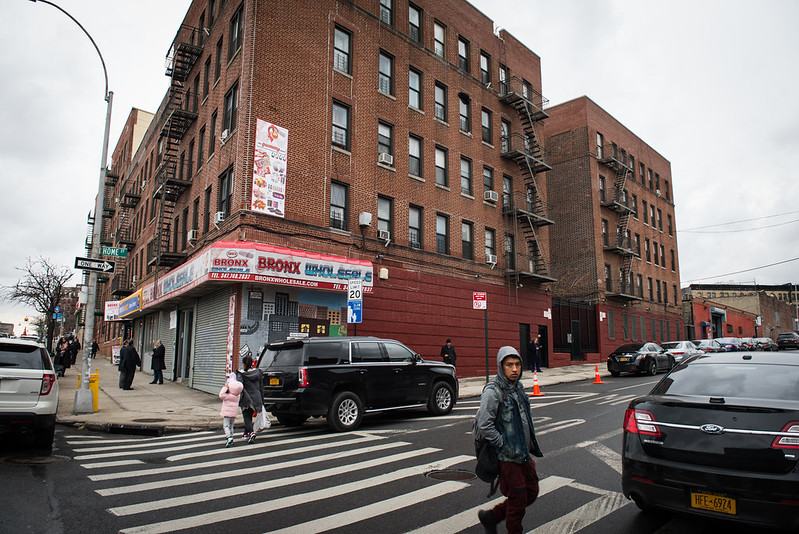
An economic crisis is upon us (photo: Edwin J. Torres/Mayor's Office)
For millions of American families, making rent each month is a familiar struggle: last October, a new analysis found that half of American renters were spending more than they could afford on monthly rent payments. But now, with the COVID-19 pandemic ushering in a new economic crisis and the real unemployment rate at its highest level since the height of the Great Depression, America’s housing affordability crisis is a true economic emergency. An unprecedented number of households will be newly unable to pay rent – and that threatens our whole economic system.
An emergency of this magnitude requires a swift and massive response from the federal government, which thus far has not materialized. As a way to press the issue, some are calling for a statewide rent strike in New York. But this approach will harm the affordable housing stock and the tenants who live in it. Rent is required to keep the buildings maintained, staffed, and clean. Rent strikes by tenants who are able to pay also hurts the ability of an owner to help those tenants who really need it.
This problem will require a multifaceted solution set, but must be centered around direct assistance to renters in the form of flexible emergency rental assistance and far more robust stimulus payments.
It is clear that renters need immediate help: last month, a nationwide survey by the National Multifamily Housing Council found that just 69 percent of American renters paid their rent by April 5, a year-over-year decline of 12 percentage points. While the figure rose to 84 percent a week later, there is evidence that these trends are more pronounced in the areas hardest-hit by the coronavirus, like New York City.
There is no question May will be worse. The national economic crisis has deepened, with tens of millions more out of work, and those who were struggling a month ago are likely facing even tighter budgets today. That is a real threat not just to the individual families but also to our entire economic system.
The affordable housing stock has thinner margins and less cash flow than its market rate counterparts and tends to have less in reserves. Many New York State Association for Affordable Housing (NYSAFAH) member buildings have already seen far lower levels of rent collection than the surveys of residential buildings as a whole have reported.
Rent payments ensure that families live in quality apartments maintained with basic services. It pays the salary of the building service workers who maintain sanitary conditions. Crucially, a suspension of rent would also freeze liquidity that is used to build the affordable and market-rate housing New Yorkers, and Americans across the country, desperately need to ease the housing crisis in the first place.
Rental assistance will keep that system in place while also protecting the most vulnerable among us. By building on the foundation set by the Emergency Solutions Grant (ESG) program, that assistance can be rapidly distributed, providing immediate housing security to American renters while preserving the sanctity of their buildings.
The fight ahead will not be easy, but it is absolutely necessary. We must all band together and raise our voices as one to demand the real protections that American renters deserve.
***
Jolie Milstein is the president and CEO of the New York State Association for Affordable Housing. On Twitter @NYSAFAH.
***
Have an op-ed idea or submission for Gotham Gazette? Email This email address is being protected from spambots. You need JavaScript enabled to view it.
The Pandemic Preys Upon Pollution’s Victims and Shows the Power Path Ahead
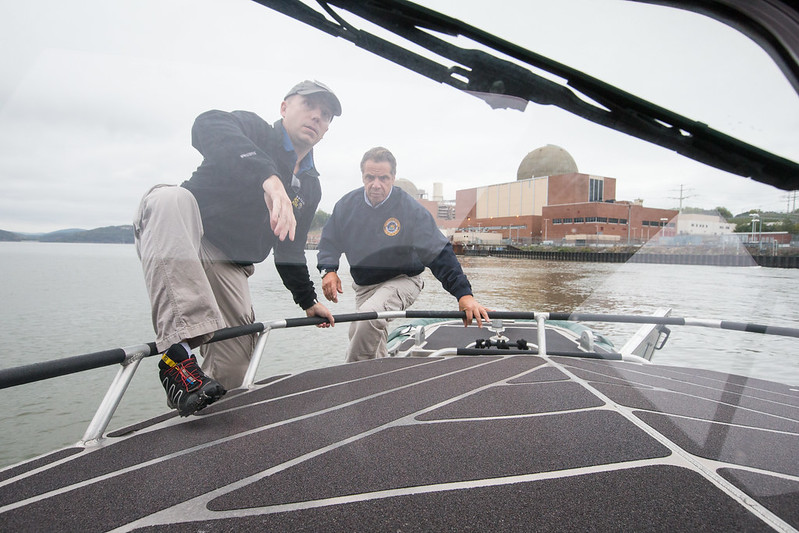
Governor Cuomo near Indian Point (photo: governor's office)
A silent and invisible killer, the novel coronavirus attacks the most fundamental human function that sustains life: our ability to breathe. To breathe properly, human beings need healthy lungs and clean air, specifically oxygen. And if lungs are compromised, there’s an even greater need for clean air.
As deaths in New York from COVID-19 surpass 17,000, those living in the pandemic epicenter face the compounding threat of substantially increased air pollution due to the imminent closure of one of the state’s largest carbon-free sources of power, the Indian Point nuclear power plant. The replacement power, largely derived from new and existing gas-fired power plants, will not only generate pollutants hazardous to human health, but will also (conservatively) emit 10-15 million tons of greenhouse gas emissions (GHGs), measured in carbon dioxide equivalents (CO2e), each year.
Greenhouse gases, which contribute to global warming, are invisible killers, much like COVID-19. For New Yorkers, air pollution and global warming are a double-whammy. It becomes a devastating and deadly triple-whammy for New Yorkers coping with COVID-19. If “Job one is saving lives,” as Governor Cuomo has said, then Indian Point must remain open.
We applaud the governor’s deference to science, data, and qualified professionals in deploying bold policies to respond to the pandemic. His recent prowess for data-driven decision-making is how all policy should be formulated. “Give me the facts,” he said of his mantra at a recent press conference. Facts are indeed the best antidote to irrational fear and anxiety.
While special interest groups such as Riverkeeper have spent years fear-mongering about Indian Point specifically, and nuclear power in general, here are the simple facts.
New York City is the second-largest consumer of power in the world, using 53 terawatt-hours per year. Indian Point generates 80% of the region’s carbon-free grid power. Generating the equivalent power from fossil fuels would increase the entire state’s electricity sector greenhouse gas emissions by 27-29%, rendering New York’s newly-enacted climate goals impossible to achieve.
“Natural” gas is mostly methane, which has 86 times the global warming potential of CO2 over a 20-year time-frame. A new analysis by the National Oceanic and Atmospheric Administration (NOAA) finds methane levels at an all-time high at 1875 parts per billion, the highest levels since record-keeping began in 1983. Most alarming, however, is that last year saw the single biggest increase in two decades. This accelerating rise in GHGs is a fact that is now keeping climate scientists up at night.
Burning fossil fuels also generates other harmful pollutants in the form of particulate matter. Fine particulates -- especially those with a diameter smaller than 2.5 microns (PM2.5) -- are particularly dangerous to the human body because they deplete lung capacity, and can pass from the lungs into the bloodstream. A new Harvard Study just released shows that long-term exposure to even a slight increase in pollution of just 1 microgram per cubic meter of PM 2.5 increases COVID mortality in a population by 15%. These results aren’t surprising. We know that comorbidities for COVID, such as hypertension, heart disease, and respiratory illness, are also associated with exposure to air pollution.
Most methane used in New York comes from fracking in neighboring Pennsylvania. Governor Cuomo recently banned fracking (for the second time - ‘permanently’ now), citing the threats of air and water pollution that it posed to New Yorkers. However, just like COVID-19, pollution does not recognize borders. Indian Point’s closure will plug New York City directly into Pennsylvania fracking fields, ensuring that New Yorkers will face even greater adverse impacts from fracking, in spite of the ban.
But of course the greatest impact will be on New Yorkers living near those gas power plants: communities of color; the same communities disproportionately impacted by COVID-19. Data released by the Centers for Disease Control (CDC) just days ago indicates that African-Americans represent 30% of COVID patients though they are only 14% of the population. Further analysis by the Associated Press found that one-third of all COVID deaths were African- American people.
In Orange County, as COVID-19 cases skyrocket a new fracked-gas plant, CPV Valley Energy Center, prepares to ramp up when Indian Point is closed. CPV is surrounded by 14 environmental justice communities. Orange County is also home to a large number of New York City first responders, who have also been disproportionately impacted by COVID. Ironically, many of them moved to the area after September 11, 2001, specifically for its once-pristine air quality.
After losing a sustained battle to stop CPV, the community now monitors their air quality daily with devices that measure PM 2.5. They’ve seen levels spike to as high as 180 micrograms per a cubic meter. When the plant is powered off, the meters read 0 -- a rare day they can take a deep breath. With CPV prepared to provide 678 MW of Indian Point’s 2000 MW baseload power, it’s unlikely they will see days like that again.
In New York City, the dense housing projects in the shadows of Astoria Gen, East River Gen, and Ravenswood power plants already have some of the highest asthma rates in the country, a comorbidity for COVID. They have some of the highest concentrations of COVID cases as well. Along with CPV, these dirty old power plants will likely be called upon to make up for Indian Point’s lost electricity.
52,000 people die every year in the United States due to pollution from fossil fuel power generation, while nuclear power saves lives. Globally, by displacing fossil fuels, nuclear power has prevented more than 2 million air pollution-related deaths. While Indian Point has provided safe, reliable carbon free power for over 50 years, irrational fear peddled by fossil fuel interests has prejudiced public perception. As an ambassador of scientific truth, we urge Governor Cuomo to correct that misperception.
The inconvenient truth is that New York plans to shut down Indian Point years before it can even hope to build enough reliable renewable power downstate, ensuring carbon lock-in for decades to come. It’s a catastrophic case of putting the cart before the horse. In the midst of a widespread pandemic and fast-approaching climate collapse it is a tragic blunder.
Melissa DeRosa, Cuomo’s executive secretary, recently commented on the importance of “being able to evolve and change in real time as facts and circumstances change.” The science is clear. Pollution plus a pandemic don’t mix. More lives will be unnecessarily sacrificed if Indian Point closes.
COVID-19 should caution us all that the laws of the natural world supersede the laws and desires of human beings; that we exist ultimately at their mercy. We cannot bend math and physics to our will. As the 50th Earth Day remembrance just again raised awareness of an even greater looming crisis, climate change, we should use this opportunity to recalibrate and “evolve” within the mandates and limits of nature.
***
Pramilla Malick is the Chair of Protect Orange County. Jim Hansen is Director of the Climate Science, Awareness and Solutions Program at Columbia University’s Earth Institute.
***
Have an op-ed idea or submission for Gotham Gazette? Email This email address is being protected from spambots. You need JavaScript enabled to view it.
Ferries Will Play an Even More Important Role in the Pandemic’s Aftermath
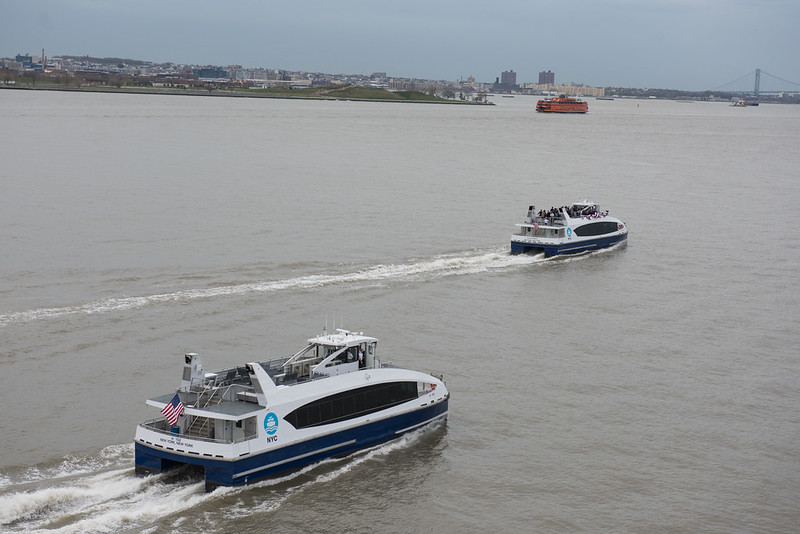
NYC Ferry program could become more important (photo: Michael Appleton/Mayor's Office)
There’s no doubt we’ll see changes in almost every facet of our daily lives after the coronavirus pandemic, but perhaps none will be as dramatic as the answers to the question of how New Yorkers will move safely around the city, including in our travels back-and-forth to work. Studies show that even if we drastically reimagine our economy, roughly two-thirds of employees -- at the very least -- will still need to commute, and the subways have been the lifeblood of the city for a century.
The subway system will remain the lifeblood of our city, and will undoubtedly adapt as best it can to new standards of safety and health in New York. But a quiet transportation revolution has been taking place in recent years that has altered thousands of commutes by taking advantage of one of our city’s greatest attributes, which can also help during our coronavirus-altered reality.
That revolution is the resurgence of our waterways and the robust and resilient ferry service that has come along with it. All up and down the East River and other points in Brooklyn with NYC Ferry, and to New Jersey and up the Hudson River with New York Waterway, ferries have been providing safe, efficient, and convenient trips for millions of commuters. NYC Ferry alone, in three short years of operation, has served almost 20 million riders.
As COVID-19 continues to change the fundamentals of human interaction, it’s become clear that these ferries provide a trip that is also far safer and healthier than other modes of transportation, largely because of their design and the federal rules that ferries operate under, which ultimately allow for more social distancing. The continuous monitoring of public spaces, by crew that today are wearing personal protective equipment (PPE) and undergoing daily temperature checks, are able to provide a more thorough upkeep and cleaning of the commuter space compared to what can be done on other modes of public transit.
Ferries are also flexible in a way that the subways and buses are not, from the vessels themselves to ferry networks as a whole. To begin, ferries have open upper decks, providing outdoor space. Riders aren’t hunkered down in a dark tunnel while on a ferry. Open decks mean fresh air (every day) and sunshine (most days). And there is enough room for everyone to stay safely apart. On NYC Ferry, for example, there are 165 seats on boats with a capacity for 149 passengers. That means even if the boat is 100-percent full, there are empty seats – seats that act as a buffer between passengers, in addition there is ample standing room indoors and on the outer decks. Same goes for the larger 349-passenger vessels.
Similarly, ferry systems can provide flexibility and ease of implementation that other transit systems lack. New routes can be added without the cost or disruption of building new subway tunnels, and vessels can be interchanged with relatively little disruption to meet demand. Due to anticipated budget cuts, overnight Staten Island Ferry service is expected to be scaled back, but essential workers will still require an affordable and convenient method of transportation. The smaller vessels operated by NYC Ferry, which is already set to expand to Staten Island later this year, could effectively and efficiently replace the overnight Staten Island Ferry service at the current overnight ridership demand, until the budget and demand allow a return to regular overnight operations.
The boats can also be re-configured to have more room for bicycles, which will likely be used even more after the pandemic subsides as commuters stay off the subway and look to other ways to commute.
On NYC Ferry, there are ADA-accessible, full-service restrooms that allow passengers to wash their hands. And hand-sanitizer stations are installed on all vessels along with notices to remind riders about CDC-recommended precautions individuals can take to stop the spread of germs.
At the end of the day, New Yorkers will need all the mass transit options they can get, including ferry service, which is relatively simple and efficient to scale up as we conform to what will likely be new social distancing norms for the foreseeable future. The waterfront’s role will continue to grow, but now with a sense of spatial necessity. But perhaps that greatest value ferries can provide? Each passenger on a ferry is one less passenger on a subway and in this new reality, when it comes to space, it’s quality over quantity.
***
Thomas J. Grech is President & CEO of the Queens Chamber of Commerce. On Twitter @QueensChamber.
***
Have an op-ed idea or submission for Gotham Gazette? Email This email address is being protected from spambots. You need JavaScript enabled to view it.
The Governor’s Clemency Negligence
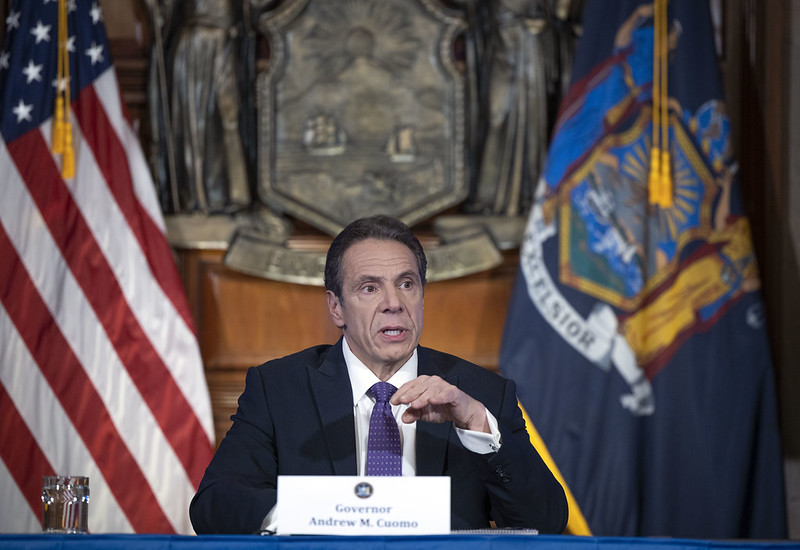
Governor Cuomo (photo: Mike Groll/Office of Governor Andrew M. Cuomo)
At his daily coronavirus press briefing on Sunday, April 26, Governor Cuomo was asked whether he had any plans to grant broad clemencies to people in prison, particularly to vulnerable populations. His testy and dismissive response – “How about if they are violent and just started their sentence?” – was telling. Presumably, the governor meant to remove from consideration people he believed remained a threat to public safety and had not been sufficiently punished.
The reporter’s question was ultimately about the perilously unsafe conditions in New York state prisons as nearly 1,300 staff and incarcerated people have already tested positive for COVID-19. The governor’s apparent disregard for anyone recently convicted of a violent crime is reminiscent of times when convicted people were sent to places like Devil’s Island where leprosy and other diseases flourished, and tens of thousands of incarcerated people died.
Public health officials in New York, nationally, and all over the world have cited prisons as petri dishes for the spread of the virus, and have called on government leaders to release people so that it becomes somewhat possible to maintain social distance and stay alive in prison. Otherwise, especially for those the CDC defines as most at-risk from COVID-19, numerous prison sentences will transform into death sentences.
Even engaging in the clemency debate on the terms spelled out by the governor, what about releasing those convicted of violent crime who have served twenty, thirty, forty, or more years? Countless people in New York state prison have served decades, many defined by remarkable achievement and transformation.
They have completed, facilitated, designed, and implemented programs; they have obtained GEDs, associates, bachelors, and masters degrees; they have learned several trades; they have the support of people inside the prison and robust re-entry plans with family members who are waiting, and praying, with open arms for their release. And, to the governor’s stated concern about violence, they are older and, as every study ever done shows, have aged out of any likelihood of committing another crime. They are no threat to public safety, and have much to offer their families, communities, and society at large
Thousands of people in New York State prisons have submitted clemency applications, many well before the coronavirus outbreak. Many of the applicants are elderly. Many have health issues. Very few “just started their sentence.” Countless among them merited clemency in their own right before COVID-19 came behind the bars. Now, their meritorious applications are joined by the urgency of a public health crisis of untold magnitude.
While clemency is usually cast as an act of mercy or charity, at this moment it is a matter of life and death. The governor’s power to grant clemency is firmly rooted in the state constitution. It is well past time for Governor Cuomo to use it.
***
Steven Zeidman is a professor of law at CUNY School of Law. On Twitter @SteveZeidman.
***
Have an op-ed idea or submission for Gotham Gazette? Email This email address is being protected from spambots. You need JavaScript enabled to view it.




